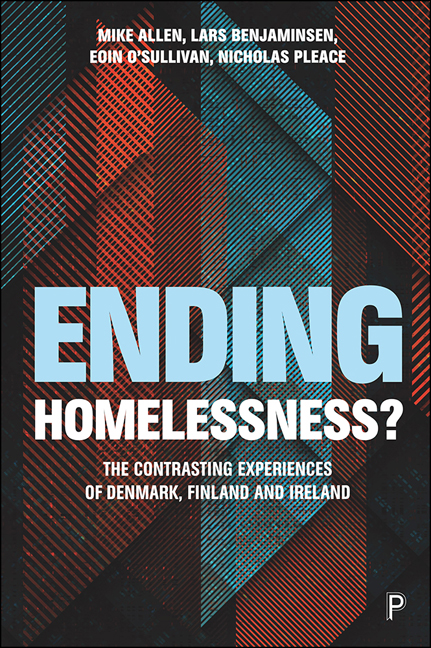Book contents
- Frontmatter
- Contents
- List of Figures and Tables
- Acknowledgements
- 1 Ending Homelessness? Policy and Progress in Denmark, Finland and Ireland
- 2 Before the Goal of ‘Ending Homelessness’: the Evolution of Policy
- 3 The Strategies Described
- 4 Trends in Homelessness in Denmark, Finland and Ireland
- 5 Explanations: Housing Matters
- 6 Explanations: Welfare and Politics Matter
- 7 Conclusion
- References
- Index
2 - Before the Goal of ‘Ending Homelessness’: the Evolution of Policy
Published online by Cambridge University Press: 25 February 2021
- Frontmatter
- Contents
- List of Figures and Tables
- Acknowledgements
- 1 Ending Homelessness? Policy and Progress in Denmark, Finland and Ireland
- 2 Before the Goal of ‘Ending Homelessness’: the Evolution of Policy
- 3 The Strategies Described
- 4 Trends in Homelessness in Denmark, Finland and Ireland
- 5 Explanations: Housing Matters
- 6 Explanations: Welfare and Politics Matter
- 7 Conclusion
- References
- Index
Summary
Introduction
This book is focused on the formulation and delivery of strategies to end homelessness that the three countries adopted from around 2008. However, it is useful to reflect briefly on the recent history of responses to homelessness in each country as these histories influenced the ways in which the early 21st-century strategies were framed and developed.
The 20th century
Most economically developed countries in Europe, including the three that are the subject of this book, initially pursued policies that were grounded in assumptions about homelessness that began with a picture of lone, economically marginalised, adult men who had, in some way, chosen an itinerant lifestyle, often linked to alcohol dependency. Over the last three decades of the 20th century, homelessness policy was characterised by an increasing emphasis on treatment and support. This shift reflected broader trends across the economically developed world as homelessness came to be seen as associated with sets of shared characteristics such as addiction, alcoholism and severe mental illness.
Finland (Y Foundation, 2017; Fredriksson, 2018, cited in Ranta, 2019), Denmark (Kolstrup, 2014) and Ireland (O’Brien, 1981; Kearns, 1984) all experienced this transition, although the details and time frames varied somewhat across the three countries, as is described later. All three countries also saw the development of social housing at scale. Social housing was seen as an integral part of wider social policy, designed to increase affordable housing supply rather than the pursuit of free market housing policy.
The first phase in homelessness policy was surveillant: an attempt to contain, control and discipline. The second phase stemmed from medicalisation, emphasising the need to treat and support, but this was framed in the context created by the first phase. As the three countries developed their homelessness strategies at the beginning of the 21st century, a third phase in which services started to be modelled differently was underway. Choice, recovery and strengthbased approaches, and housing-led models that included, but were not restricted to, what became the global Housing First movement, were gaining momentum.
Denmark
In Denmark, rapid economic growth from the 1960s onwards saw a significant expansion of the welfare state, alongside major shifts in how welfare systems operated.
- Type
- Chapter
- Information
- Ending Homelessness?The Contrasting Experiences of Denmark, Finland and Ireland, pp. 29 - 46Publisher: Bristol University PressPrint publication year: 2020



